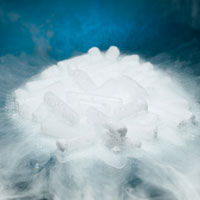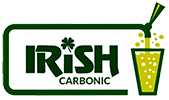

Think you know all the uses for dry ice? We bet you don’t! Here are 20 things you can do with dry ice, and we’re sure there are some we missed!
- Making plants grow faster – In small amounts, CO2 will increase the growth rate of plants. Allow the dry ice to sublimate near plants for 10-15 minutes daily.
- Removing bed bugs – Most of the chemicals used to control bed bugs are either banned or restricted; dry ice traps do the trick without the toxins.
- Preserving food during a power outage – Put your food on dry ice to keep it from spoiling during a power outage.
- Transporting perishable food for camping – Want to bring frozen food or perishables on your next camping trip? Bring along some dry ice and a cooler.
- Slowing hair loss during chemotherapy – Many cancer patients undergoing chemotherapy treatments use supercooled “cold caps” to reduce or prevent hair loss.
- Dry ice blasting – Similar to sandblasting, dry ice blasting uses a jet nozzle and compressed air to shoot small pellets of dry ice. The extreme cold causes targeted material to shrink, allowing for easier removal.
- Preserving game for hunters and fishermen – Use dry ice to minimize spoilage when you transport wild game.
- Flash freezing fish – Dry ice can be used to flash freeze fish, keeping them fresh for up to ten days longer than regular ice.
- Creating Halloween effects – When combined with hot tap water, dry ice will produce a spooky display of voluminous fog. Use a pound of dry ice for every 4L of hot water for 5-10 minutes of maximum effect.
- Freezing fruit – Place dry ice in the bottom of your cooler and the fruit directly on top. Close cooler and let fruits freeze for 20-30 minutes.
- Preserving a body for a funeral – Dry ice can be used to preserve the human body until the funeral; this method is less toxic for the environment and less costly for the family.
- Fighting fires – Dry ice can deplete oxygen in a space, which helps to control fires.
- Trapping mosquitos – Mosquitos associate carbon dioxide with the presence of blog (since animals exhale CO2); as dry ice sublimes to CO2 gas, it is equivalent to over 1,000 people breathing at the same time in close proximity. Place 5-10 pounds pieces of dry ice away from areas where people are gathered.
- Removing warts and moles – Doctors will often use dry ice to freeze and remove warts or other skin imperfections.
- Repairing plumbing pipes – Dry ice can be used to quickly freeze pipes, stopping the flow of water at the point of contact. This method is very useful if you are unable to access the main shutoff valve.
- Preserving grains and seeds – Bacteria, fungi, and insects can spoil a harvest, but sublimating dry ice will displace oxygen in a grain holder, keeping contents at low temperatures to kill fungi and bacteria.
- Fixing car dents – Allow the dent to sit in the sun to warm up (or use a blow dryer), then place a 10-pound slab of dry ice directly over the dent. The rapid cooling of the metal will pop the dent back to normal.
- Removing old floor tiles – Dry ice will freeze adhesive through vinyl and plastic tiles, breaking the adhesive bond and allowing you to remove tiles with far less effort.
- Fitting metal – Dry ice works wonders for metal shrinking and fitting.
- Theater effects – Use a fog machine or buckets of hot water and a fan to create mysterious fog effects.
Need dry ice for…well, just about anything? We’ve got it! To buy dry ice in Rochester or Buffalo, NY, trust the pros at Irish Carbonic. Contact us today to learn more!

Carbonated water is a delicious way to wash down a great meal, especially once the warmer weather starts arriving in the coming months. But who wants to buy all that carbonated water in the store when you can easily make it at home?
Here are three ways to do it:
Using a seltzer bottle
Seltzer bottles have a tube, a main chamber, and a head with a dispensing leaver, along with a carbon dioxide charger to carbonate water (an alternative to a seltzer bottle that uses similar technology contains the carbon charger within a separate stand; SodaStream is one well-known brand of this type of carbonator).
To make seltzer with a seltzer bottle,
- Fill the bottle with tap water, leaving a bit of space for gas expansion.
- Insert the tube into the base, then screw the head onto the bottle.
- Insert a carbon dioxide cartridge in its holder and place it in the slot on the side of the head; the holder pierces the cartridge, allowing carbon dioxide to flow into the base through the tube.
- Shake the seltzer bottle for 10 to 15 seconds to disperse the carbon dioxide throughout the water.
- Remove the cartridge holder from the head, then squeeze the leaver to dispense your drink.
Using yeast
You can also make carbonated water using yeast; yeast works because it eats sugar, leaving carbon dioxide as a by-product. You’ll need about 1/8 tsp. of yeast to make a gallon of carbonated water, following these steps.
- Fill a gallon-sized bottle with a warm beverage you want to carbonate; the yeast will not work in cold water.
- Add yeast. You can use different kinds of yeast; if you can find it, champagne yeast is usually the best choice because it does not change the taste and stays at the bottom.
- Cap the bottle and shake it well.
- Place the bottle in a dark, warm place for a few days to ferment.
- Once it’s ready, refrigerate the bottle to halt the fermentation process. While you drink the beverage, pour it in a way that keeps yeast sediment at the bottom of the bottle.
Use dry ice
Dry ice is solid carbon dioxide – the gas used to make carbonated beverages – so you can also use it to make carbonated water. ALWAYS FOLLOW PROPER DRY ICE SAFETY INSTRUCTIONS WHEN HANDLING YOUR DRY ICE BLOCK.
To carbonate beverages, simple cut your dry ice block into ice-cube sized chunks, add them to a glass of your favorite beverage, and wait for it to dissolve (it will smoke as it does this, adding an extra element of “cool” to the proceedings).
Two or three ice-cubes worth of dry ice takes about four or five minutes to dissolve; make sure the cubes have completely disappeared before drinking.
Check out this video to see more dry ice drink carbonation in action!
Need dry ice for your business, or just for fun? Irish Carbonic has it. Contact us today to learn about our dry ice products, bulk CO2 deliveries, beverage grade CO2, and more for your bar, restaurant, or industrial business!

You probably know carbon dioxide (chemical formula CO2) as the gas you release when you exhale. But don’t sell the molecule short: besides ridding our body of metabolic and biochemical waste, CO2 has a wide range of uses in restaurants, breweries, health care facilities, water treatment plants, and much more.
One of the fastest-growing applications of CO2 is in the production of food and beverages, where the gas is used in numerous ways – including as a carbonating gas for beer and other beverages.
When frozen, CO2 becomes dry ice – a versatile product that can be used for everything from cryogenic blasting to cold chain food transportation.
Another interesting application of CO2 comes in fire fighting, where the gas is used to “choke” a fire by reducing oxygen in the air surrounding it. You’ll also find CO2 being used as an insufflation gas in minimally invasive procedures such as arthroscopy, endoscopy and laparoscopy.
These applications and more have led to an increase in the demand for carbon dioxide, which makes finding a reliable bulk CO2 supplier very important if you use it in your operations.
At Irish Carbonic, we can support your CO2 needs at every phase of your company’s lifecycle. Our technicians and staff will provide the bulk CO2 supply and expertise you need to keep everything running like clockwork.
From convenient deliveries and expert planning to personalized priority service, we’ll work with your company to develop an industrial CO2 solution that makes sense for your operation and budget.
Whether you’re looking for a reliable CO2 supplier for your restaurant or bar or a design consultant to help you understand how to integrate CO2 equipment into the workflow of your greenhouse or any other operation, we’re ready to tackle your industrial CO2 challenge.
Our expert technicians and staff will work with you every step of the way, helping you find economical solutions that keep your operations running reliably and efficiently.
We offer:
- Reliable supply — Our fleet of trucks will get you the CO2 you need, where and when you need it. We’ll keep pace with your demands even through peak times when CO2 supply may be difficult to come by. Bottom line: you can rest easy knowing there is little risk of a CO2 run-out.
- Personalized service — At Irish Carbonic, we put your business first, finding ways to service you faster and more personally than other area suppliers. We’re there for your 24/7/365, offering convenient service and reliable bulk CO2 deliveries in Buffalo and Rochester, NY.
- Expert planning — Our team of pros will work with you to develop an industrial CO2 solution that makes sense for your business and budget.
For reliable bulk CO2 deliveries, beverage-grade CO2 supply, dry ice delivery, and more, contact the pros at Irish Carbonic. Our CO2 experts are standing by!

The holidays are here – time for yuletide beer! But what exactly defines a beer as a Christmas brew?
As it turns out, there is quite a lot of leeway when it comes to categorizing brewed holiday concoctions – which explains why everything from a German Weihnachtsbie to a Californian IPA can bear the holiday moniker. But that doesn’t mean there aren’t guidelines, traditions, and best practices to holiday brewing.
Typical characteristics of a holiday beer
When you’re talking about a beverage that has its roots in Viking winter solstice festivals and offerings to the gods, it’s sure to have some strong, distinctive characteristics – and that is indeed the case among most holiday brews.
Typical holiday beers tend to:
- Be full bodied
- Come with rich malt bases
- Contain more alcohol
- Be dark and flavorful
Some of the more popular holiday styles of beer include stouts, porters, richer brown ales, and Belgian-style dark strong ales. Spicing is also common in holiday brews, with cinnamon, nutmeg, allspice, ginger, orange peel, star anise, and others often making an appearance.
Ensuring the perfect holiday pour
Winter holidays and beer drinking have gone together for more than a millennia, so it’s a great idea (and great business) to continue that tradition at your bar, pub, or restaurant this year. Just be sure your beer lines are up to the task, and that you have enough bulk CO2 and mixed gas on hand to get perfect pours every time on your ales, stouts and more!
Serve up perfect holiday brews at your pub, bar, or restaurant this winter with expert beer line cleaning service, beer line installations and maintenance, and bulk CO2 deliveries in Rochester and Buffalo from Irish Carbonic. Don’t risk a skunky holiday pour – contact us today to learn more!
 Today’s headlines feature some frightening stories about food handling – whether we’re reading about recalls on chicken, salmonella or E. Coli scares, or even tainted pet food.
Today’s headlines feature some frightening stories about food handling – whether we’re reading about recalls on chicken, salmonella or E. Coli scares, or even tainted pet food.
You might ask why we’re talking about safe food handling on an Irish Carbonic blog (it’s a fair question, after all). The answer comes down to two words: dry ice.
If your business operates in the food manufacturing and processing industries, you’re constantly shuttling food in and out of food plants, and much of that movement is done via a cold chain that’s kept that way using dry ice and dry ice containers.
Dry Ice And Food Safety
If that’s true for you, it’s critical to always do three things:
- Strictly follow FDA guidance and regulations – Information about food safety programs, manufacturing processes, industry systems, and import/export activities can be found on the U.S. FDA website.
- Use high-quality dry ice – Always use impurity-free dry ice for jobs that include a food production or food-handling component. The best way to ensure that you have top-quality dry ice? Buy it from Irish Carbonic.
- Clean your dry ice containers and food production equipment regularly – Daily maintenance is the key reducing bacterial or fungal cells and preventing them from moving among your facilities. If you need dry ice containers for your food handling facility, give us a call – we’re help you source them.
Irish Carbonic sells quantities of dry ice ranging from individual portions of dry ice rice pellets to massive 10,000-pound commercial deliveries in block form – available for pickup or convenient delivery to your location. Contact us today to learn more!

Yes, the holidays are about gathering in celebration with people we love and reflecting on another year gone by.
But let’s be real: it’s mostly about the food.
If you can’t be with your family or friends this year but what to share the joy of the season by cooking or baking something special, that’s a great gift idea. But how do you get it to them if your dish is perishable?
The secret to safe food shipments
Simple: use dry ice.
Dry ice is the perfect way to send perishable foods by mail this holiday season – but you need to take special care if you want your precious cargo to arrive safe and fresh. Here are some basics to shipping with dry ice – if you need further help or explanation, contact us. Always remember to follow dry ice safe handling instructions!
- Start with the right packing materials – Heavy duty corrugated cardboard, plastic, or wooden boxes will stay insulated, protect your food, and keep dry ice bags from breaking.
- Add a Styrofoam lining – Constructing a Styrofoam liner for your shipping box will add further insulation and protection. A disposable cooler works great – just don’t seal it!
- Pack to retain the cold – Wrap food in plastic or paper bags prior to packing. Pack the food and dry ice together tightly, using newspaper or cellulose to minimize gaps and provide insulation. Packs of dry ice should be on the bottom, followed by food items. Alternate between dry ice and food items, filling in gaps with bubble wrap and newspaper until the box is full. If you’re using a Styrofoam cooler, do not seal it completely as this can prevent the package from releasing pressure.
- Double check your shipping address – Dry ice will eventually sublimate (disappear as it turns into a gas, since dry ice doesn’t melt); when it does your food will spoil.
- Follow hazardous material instructions for shipping – This is the biggie: dry ice is considered hazardous material, so it needs to be marked properly prior to shipment. Ask for the following labels at your post office or from your courier (FedEx, UPS, etc.):
- A label that says “Dry Ice” or “Carbon Dioxide Solid.”
- A label that reads UN 1845 (indicates hazardous materials).
- A label that indicates the net worth of dry ice in your container (keep track of how much dry ice you use!)
- A Class 9 label – This indicates that the package contains dry ice – they’re free at most post offices and from your courier. Put the Class 9 label on the same side of the package that contains the UN 1845 label.
Once your labels are complete, be sure to ask for the proper paperwork, which could include a shipper’s declaration (a slip that includes basic information about yourself and the recipient).
- Other considerations – Dry ice lasts a maximum of about three days; overnight shipping is usually best, especially when shipping items like meat. Do not choose options that take more than two days to ship. And be prepared for extra regulatory costs – Call your local post office or courier for details.
Need dry ice to ship your holiday treats? We’ve got it available for pickup at each of our convenient Irish Carbonic locations in Buffalo, Rochester, and Columbus, OH. Contact us to learn more.

If you’re a bar or restaurant owner, you have probably heard about or even considered adding nitro taps as demand for complex and flavorful craft brews continues to grow.
But how much do you know about nitrogen beers and the qualities that set them apart from other brews? Here’s a nitro beer Q&A to get you started.
What is “nitro beer”?
The term “nitro” refers to nitrogen – the gas used to carbonate certain kinds of craft beers. Most nitrogen beers contain a mix of gases – typically 30 percent carbon dioxide and 70 percent nitrogen. One distinguishing characteristic of a nitro brew is its distinctive head – the result of nitrogen’s inability to dissolve in liquid (Guinness – an Irish Stout – is perhaps the most well-known nitro brew).
What nitro beer varieties are available?
Most of the nitro beers available today tend to be malt heavy stouts and porters rather than IPAs, because nitrogen typically responds better to grain-based brewing. But that is starting to change as brewers search for new and exciting ways to create products that will stand out from the crowd. Cream ales, nitro IPAs, and double altbeirs have recently started to become more commonplace.
What do I need to add to my bar if I want to offer nitro brews?
If you’re considering adding a nitro tap to your bar, you will need to invest in three things: a system to deliver blended nitrogen gas, a creamer faucet ( a specialized tap for nitrogen beer) and glassware made for nitro brew pours. The spout of a creamer faucet includes hundreds of small holes that filter the beer as it pours, creating the creamy, thick head your customers are looking for.
Spread the word with TapHunter
If you choose to jump into the world of nitrogen beer, be sure to spread the word to your customers so they can get their unique nitro brew experience from you rather than your competitors in the months and years to come. Registering with a beer-hunting app like TapHunter is a great way to get on the map (literally!) with beer connoisseurs in Buffalo, Rochester, and beyond!
Ready to jump into nitro beer crafting for your bar or restaurant? The beer experts at Irish Carbonic can help, with custom nitrogen tap installations, blended gas cylinders and onsite gas blending solutions, and ongoing beer tap maintenance services once your system is up and running. Contact us to learn more, or to request a FREE, no obligation estimate on a nitrogen beer tap installation today!

We all have that neighbor that goes all out on Christmas – you know, those Grizwold wannabees whose house you can see from space in satellite photos.
Sadly, you may never get to be that neighbor (or not so sadly, once you see their electric bill) – but that doesn’t mean you can’t own Halloween, with a little help from dry ice.
Imagine terrifying trick-or-treaters with a foggy-floored front porch, or delighting your party guests with a smoking punch bowl. Yes, dry ice is the perfect way to eat, drink, and be scary this Halloween – whether you want to make a smoking witch’s cauldron, a foggy Jack-O-Lantern, or even some creepy-but-cool boo bubbles.
Dry ice is inexpensive and easy to use and – just be sure to follow these simple precautions when handling it, and be sure to read these instructions to get the most dry ice fog for your buck!
Halloween is coming – creep it real with dry ice from Irish Carbonic.
You don’t need an enGRAVEd invitation – just stop in and stock up on dry ice at our convenient store locations today!
IRISH CARBONIC
1444 Clinton Street | Buffalo, NY 14206
(716) 827-2727 | Map & Directions »
IRISH CARBONIC AND PROPANE
535 Buffalo Road | Rochester, NY 14611
(585) 254-6844 | Map & Directions »
IRISH CARBONIC
772 Marion Rd | Columbus, OH 43207
(800) 884-0072 | Map & Directions »

If you really want to up the ante on your Halloween displays and parties, there’s nothing better than creating creepy, foggy effects with dry ice. But how much dry ice will you need for this year’s holiday spooktacular, and how do you make that fog effect last as long as possible?
Tips For Dry Ice Shopping
Based on our experience, you can make a two-pound block of dry ice produce fog for about 20 minutes by following these four tips:
- Use the right water-to-dry ice proportions – Aim to combine dry ice with water at a ratio of about one gallon of water to two pounds of dry ice. Use a thick, rectangular chunk of dry ice, and put it in a bowl large enough so that the water submerges the dry ice to a depth of about half an inch.
- Use a deep bowl – Ideally, you want a thick, plastic bowl at least three times as deep as the dry ice block you’re using. A deep bowl will allow fog to gather before it spreads, which will generate a fog with a relatively uniform thickness.
- Use a small fan – Dry ice fog effects will start to dissipate about two to three feet from the bowl; to extend that range and direct the fog, use a small fan on a low setting.
- Recycle the water – If you want the dry ice effect to last, keep refreshing the water; stagnant water will not stay carbonated – the key to a great and lasting fog effect.
It is important to note that although the fog is just water and C02, you should always allow for adequate ventilation when using dry ice in general, and particularly for fog effects. And, as always, follow your dry ice safe handling instructions!
Be the ghostess with the mostest this Halloween – stop in and stock up on dry ice for your Halloween party at our convenient store locations! Contact us today to learn more.
IRISH CARBONIC
1444 Clinton Street | Buffalo, NY 14206
(716) 827-2727 | Map & Directions »
IRISH CARBONIC AND PROPANE
535 Buffalo Road | Rochester, NY 14611
(585) 254-6844 | Map & Directions »

Dry ice is some cool stuff – literally – at -109.3 degrees Fahrenheit. But what you can do with it is even cooler.
Dry ice is solid carbon dioxide – the gas that makes your drinks fizzy (and the stuff you breathe out when you exhale). Dry ice does a lot of other things, too, including making some awesome displays for Halloween (more about that in a couple of weeks…stay tuned!).
Dry ice safety
Experimenting with dry ice can be fun for kids – but you need to be careful with it. Dry ice is so cold that it will actually burn you (like frostbite)! Always follow safe handling instructions for dry ice, including these:
- Never touch it with your fingers – use tongs or gloves
- Never put it in your mouth
- Never lock it in a closed or sealed container – it can explode as it sublimates (turns from a solid into a gas).
Fun dry ice experiments for kids
Here are some fun experiments your science-loving kids can try with dry ice. Have any more? Let us know!
- Disappearing ice – Place a regular ice cube and a cube of dry ice side by side on separate plates for one or two hours; when you return, the ice cube will leave water behind; the dry ice will have completely disappeared.
- Smoke bubbles – Add a few drops of liquid dish soap in a tall glass of water. Carefully place the dry ice into the soapy water using gloves or tongs. With the liquid dish soap in the mix, the soap in the water traps the CO2 and water vapor to form a bubble. Try adding food coloring to the water for colored bubbles.
- Floating dry ice bubble – Fill a deep baking pan or aquarium with about one inch of water, then add a few pieces of dry ice using tongs. The dry ice will “smoke” as the CO2 and water vapor combine. If you blow bubbles (from a bubble wand) into the tank, the bubbles will appear to float in midair inside of the container; they are actually floating on CO2.
- Bubbling beverages – Filling a bowl or pitcher with your juice of choice, then add a few pieces of dry ice using tongs. As your drink begins to bubble, the juice will become carbonated – just like soda.
- Inflate a balloon – Put a deflated balloon over the opening of one of your bottles and watch it grow. The balloon catches all the carbon dioxide gas as it sublimates. Since carbon dioxide is denser than air, it will also sink to the ground.
Need dry ice for your latest experiments? Irish Carbonic has it at our convenient Rochester and Buffalo locations. Contact us today to place your order!






